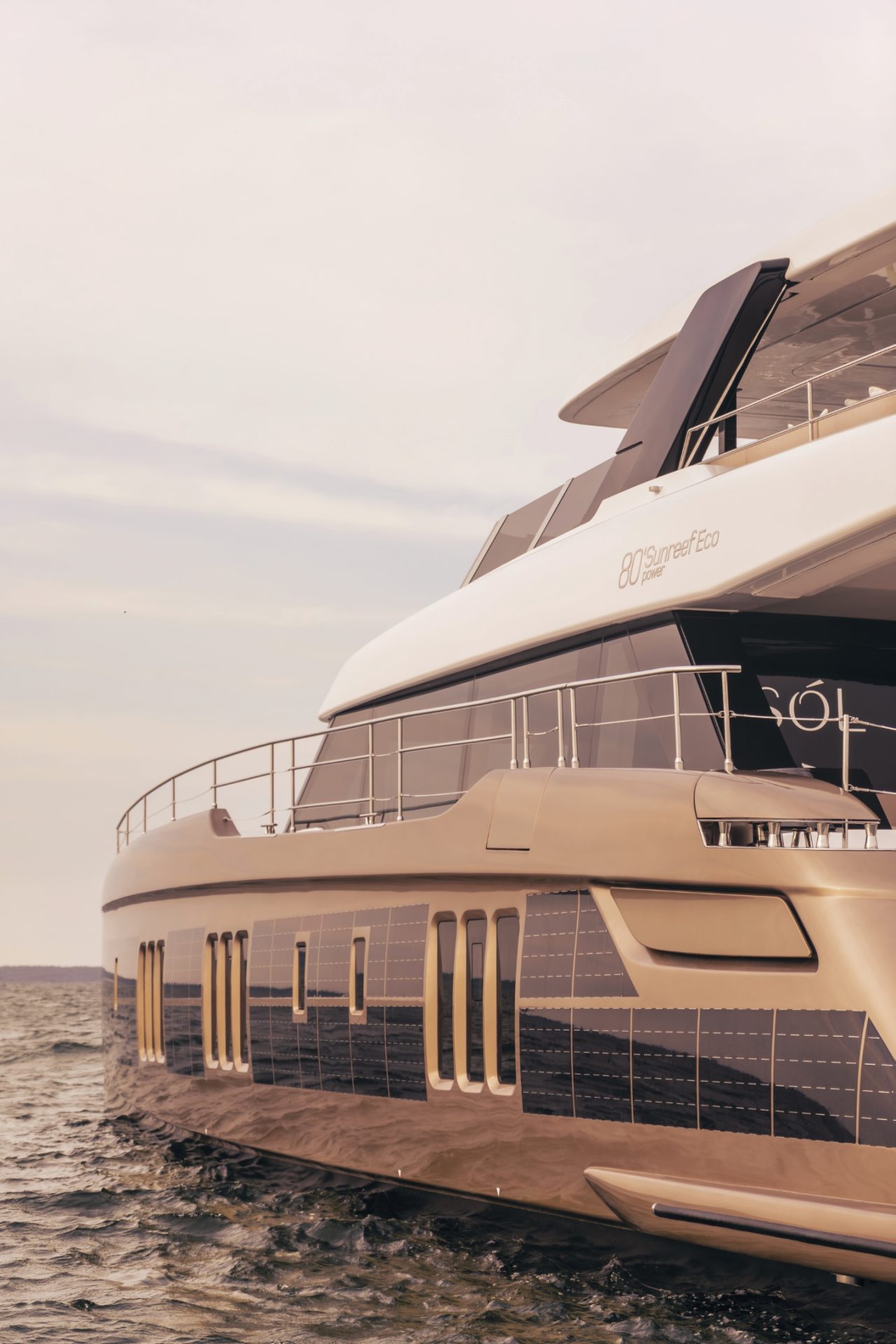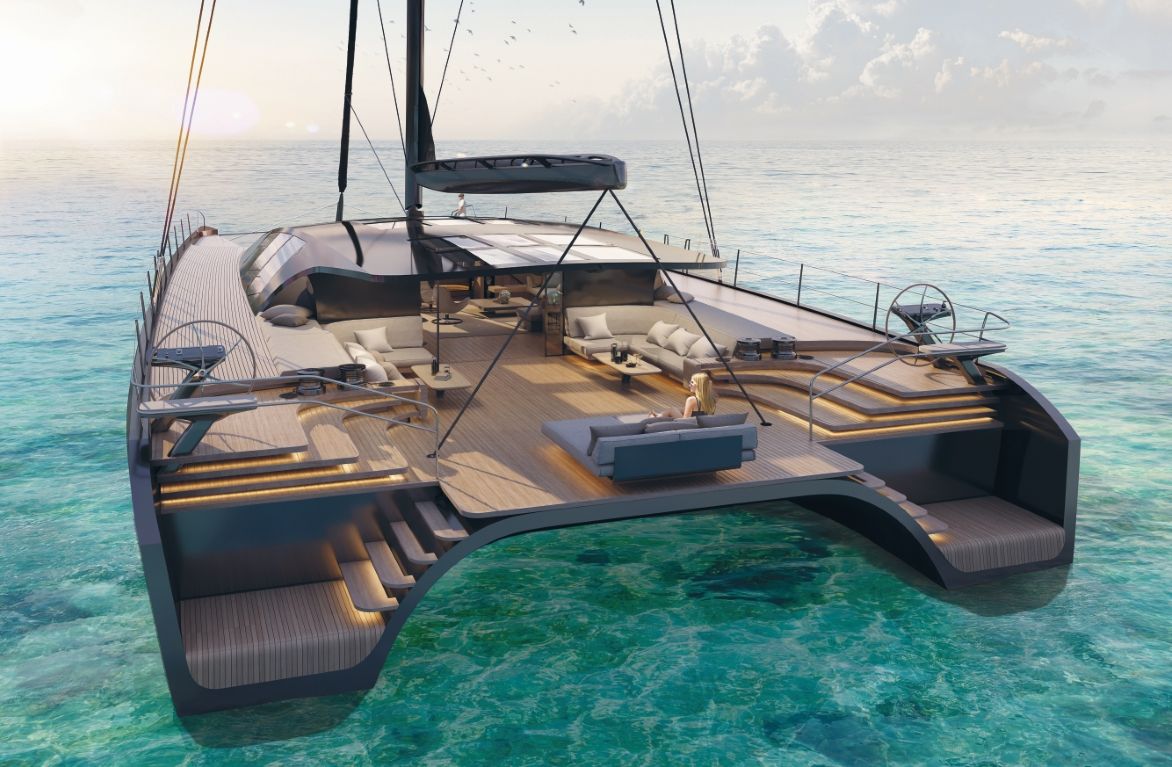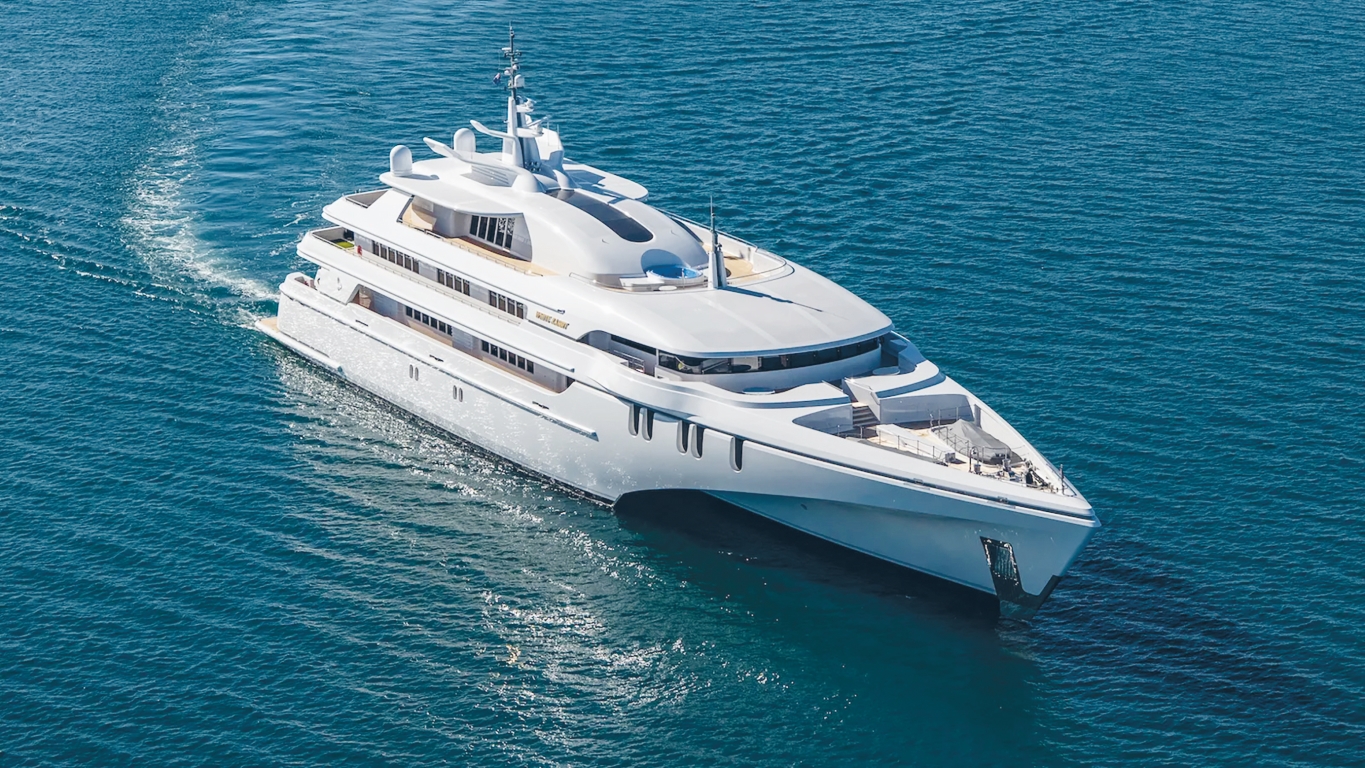Leap of space
The drive to explore further for longer – with more people, provisions and possessions on board – is not just fuelling the increasing interest in larger multihulls, it’s also pushing designers to innovate with materials and techniques.
Written by Jeni Bone
19 March 2024
An appetite for larger and more complex vessels is igniting the creative talents of designers as owners express a desire for more ambitious itineraries. According to the 2023 Global Order Book and reports from international designers and builders, there has been a huge rise in demand for multihulls – a trend that continues as owners seek to travel further for longer periods and with more space for guests to enjoy the experience.
“The multihull movement certainly gained momentum in Australia and New Zealand in the ‘70s and ‘80s, with our commercial shipyards designing fast passenger vessels,” states superyacht designer Misha Merzliakov.
“Designers and owners took notice of the platform and its advantages and joined the dots – smaller engines, just as fast, stability, more space, and the two-engine redundancy if they go further afield. There was a real boom in catamarans such as Bruce Harris’s Shark Cats, Scimitar, Lightwave and many others. Open-plan living and more social space really appeals to Australians.”
Over the years, the smaller production and semi-custom cruising cats have flourished, but at the larger end, owners were less adventurous – until now. “We’ve reached a turning point,” asserts Merzliakov.
“Superyacht owners might be early adopters in their businesses but not necessarily in their boats. It’s taken a decade or so for them to gain confidence by seeing more of them on the water and understanding the benefits. With the perfect storm of higher fuel prices, people see multihulls as an attractive offering.
“Comparing like for like – a 30-metre monohull and a 30-metre multihull – you have so much more deck space and living area. The key thing we’re seeing with clients is that they can have large numbers of guests on board and accommodate them, and then double that number for entertaining.
“Australian designers and builders have cracked it wide open. Multihulls are going gangbusters,” enthuses Merzliakov, who most recently designed the 40-metre catamaran known as Project Orion, and has another much larger cat on the drawing board.
Along with space, another advantage is economy. “They can run on smaller installed horsepower and therefore offer better fuel efficiency, plus a shallower draft means owners can explore further afield into remote or sensitive waterways.”
Owner requirements are as unique as the owners themselves, but in Merzliakov’s case, he has several clients requesting designs that take into consideration the needs of three generations. “As such,” he notes, “safety for younger children is a priority, as is ease of access for older members of the family.”
For Project Orion, Merzliakov teamed up with Shaun Phelps from Periscope Naval Architects and Juan Koegelenberg for the first model from a new brand of long-range superyachts, X-Plorer Yachts. “The brief was to design a sub-500-gt explorer vessel for self- sufficient, long-range cruising in the Pacific Islands,” Merzliakov explains.
“The investor wanted a vessel capable of carrying a helicopter with massive locker space for large toys, and it had to cater to three generations on board with various living spaces and deck areas for them to spread out during extended cruising.”
A shallow draft for cruising tropical waters, wide beam, structural capacity for heavy equipment, commercially rated for global charter and compliance with IMO Tier III emission standards were all requirements. Also on the wish list was a spa pool, outdoor cinema, barbecue grill and large panels of glazing for optimal views.
The power catamaran platform was ideal for providing the space, stability and efficiency that was required. “Monohulls in the sub-500- gt category do not have the beam to allow for fully compliant helidecks, and large tenders on a monohull can be challenging in terms of stability,” says Merzliakov.
International catamaran builders have all upsized their range in the past five years. Cat specialist Sunreef, with its aspirations to enter and dominate the superyacht segment, has revealed plans for its 100 Power and Zero Cat 90-foot models.
Spokesperson for Sunreef, Artur Połoczañski, says energy efficiency is one of the prime drivers of the multihull market. “With shallow draft and plenty of space for solar panels, catamarans emerge as the sustainable superyacht alternative. More and more customers notice these advantages and are ready to make that transition.
“Sunreef Yachts now has two 43-metre catamarans in the order book. Both are sail yachts with electric engines and a massive number of solar panels, offering the complete superyacht experience without any of the noise, vibration or fumes.”
The other exceptional features of multihulls are space and stability. As Połoczañski elaborates, “In recent years, we’ve had more customers interested in longer voyages. They like catamarans because they come with all the safety, energy efficiency and redundancy they are going to need for extended travel.
“Many customers also asked us for sleeker and faster designs. This is how we came up with the new Ultima range – catamarans that have a little less beam but more performance and hybrid engines.”
UK-based Malcolm McKeon Yacht Design (MMYD) has a wealth of experience gained over the design of 200 yachts, including more than 55 superyachts, with an extensive portfolio spanning monohull and catamaran sailing yachts, motor yachts and chase boats as well as tenders. “We’ve seen a lot of interest in multihulls from people coming from a power boat background who see multihulls as a more stable, comfortable platform,” McKeon notes.
“To be able to sail with all the advantages of a multihull like shallow draft, performance and the big open spaces that you just don’t see on a monohull – that sector of the market is expanding hugely.”
When it comes to onboard lifestyle and amenities, McKeon observes that clients have diverse and ambitious wish lists. “They want to equip their vessel with large tenders, beach clubs, platforms to facilitate water sports, fold-down balconies in the hull sides to create additional deck space and swimming pools. Our 75-metre catamaran design, for example, features a full-beam swim platform that can be raised and lowered and also provides options for a beach-club setup.”
Chris Blackwell, Sales and Marketing Manager at Echo Marine Group, together with Steve Quigley, Managing Director at One2three Naval Architects, and Sam Sorgiovanni of Sorgiovanni Designs all have extensive experience in creating mono, catamaran and trimaran projects.
The three parties collaborated on the award-winning 84-metre White Rabbit trimaran, and One2three is also the naval architect of the new 56-metre aluminium-hulled catamaran motor yacht that was launched by Echo Yachts in August 2023 – named Charley 2, it’s the largest luxury catamaran motor yacht built in Australia.
Designed as an adventure and support vessel, Charley 2 boasts a helipad, accommodation for 18 guests and 19 crew, an extraordinary arsenal of water toys plus two folding davits for launching them, a dive store, decompression chamber and specialist sonar equipment on the 12-metre tender.
“One of the advantages of having 40 years of experience in designing monohulls, catamarans and trimarans is that we have significant experience across all hull forms,” asserts Quigley. “And, as a design organisation, we are agnostic in terms of hull form, which puts us in the unique position to offer independent advice that is backed by real-world experience.”
Multihulls, specifically catamarans in the explorer segment, are an enormous growth area, he explains. “All over the world, designers are developing semi-commercial/ semi-motor-yacht-style cats, and hundreds of yards can build them.”
Their popularity in the charter market has led to a familiarity and confidence with these large twin-hulled vessels. “It’s a grassroots movement,” Quigley continues. “As people get to know the advantages of stability, a large open platform for socialising, safety and plenty of space for toys, they become more confident to commission their own.
“You get double the boat in terms of volume and gross tonnage – they step off a catamaran onto a 30-metre monohull, and you just can’t compare the experience. It’s a gradual process; small boat owners become bigger boat owners. The explosion of growth in the 60-, 70- and 80-foot segments filters up to the bigger superyacht end of the category, which is 50 metres and above by my definition, where it was once 35 metres.
“Large globe-crossing catamarans are seen as viable options for adventure and support vessels because of their efficient hull form and cargo-carrying capacity – you get a much larger platform and carrying capacity for toys and equipment. And, as the world becomes more energy conscious, multihulls are becoming more appealing because of their lower resistance, fuel or alternative energy source. It makes sense to cover a larger surface area in solar panels.”
Sam Sorgiovanni, designer of dozens of award-winning superyachts, says his method is to determine a client’s brief based on how they would like to use their vessel. “If it’s a choice between a multihull or monohull in the motor yacht segment, I take the brief of what a client wants out of their yacht and then give them a design comparison to show them the pros and cons,” he explains.
“When you compare a monohull and a trimaran of a similar length and volume, they can clearly see the advantages. And when they see the evidence of a trimaran’s superior seakeeping capabilities and efficiencies, they are comfortable in making the decision. There’s just not a lot of multihull motor yacht data out there; most of the multihull data is in the commercial field.”
One issue Sorgiovanni has to counter is the negative experience a client may have had on board a catamaran at sea. “They’re marvellous at anchor in a lovely bay or powering along at speed, but there’s still a stigma attached to some degree around discomfort at sea. I spend a lot of time making the distinction between catamarans and trimarans.”
Chris Blackwell, Marketing Director at Echo Yachts, is a staunch proponent of the trimaran hull, which he describes as a stabilised monohull. “Catamarans and trimarans are two totally different propositions,” affirms Blackwell. “Both have different ride comfort and natural motion at sea, and both have their strengths. Trimarans are more suited to larger builds – you get the best of both worlds.”
For reference, he cited a March 2019 feature in Boat International that compared the 84-metre White Rabbit with its trimaran aluminium hull, diesel-electric propulsion and 2,940 gt against steel monohulls of comparable gt and volume, and found it was nearly 40 percent more fuel efficient.
“It’s frustrating when other yards boast 5-percent savings using new technology when White Rabbit achieved a significantly better result based on technology that is now close to a decade old,” says Blackwell.
As Quigley enumerates, there are many advantages to trimaran motor yachts, including significantly enhanced seakeeping response compared to similar-sized monohulls. “Trimarans offer significant reductions in roll and accelerations, leading to greatly reduced motion sickness incidence (MSI) across all headings and speeds.
“A comparison study by the Maritime Research Institute Netherlands (MARIN) in 2000 showed that in higher sea states, the capabilities of the trimaran are double an equivalent-sized monohull.”
As for drawbacks, there’s the higher build cost due to more complex hull forms, fewer berths and potentially higher berthing costs. “There are fewer designers and shipyards familiar with trimarans, so there are fewer build options,” Quigley points out. “But this could be counteracted by equally fast or faster new-build delivery as existing European monohull yards are full, whereas specialist multihull yards may not be.”
Australian yards have trimaran experience dating back 20 years, yet the adoption of trimarans is only now moving into the mainstream. Large trimaran ferries and naval platforms are experiencing rising demand, primarily for transporting personnel and equipment where seakeeping capability is of paramount importance.
“The catamaran hull is well suited to explorer yachts like Charley 2, a multifunction vessel that also serves as a shadow boat. For extremely efficient, long-range superyachts where guest comfort and finish are required to a very high standard, a trimaran provides the best solution,” says Blackwell. “You can design a trimaran and change the volume and the depth of the outer hulls to tune them to mimic the motion of a monohull.”
One2three was recently chosen to design the trimaran research vessel for the Australian Institute of Marine Science (AIMS), based on the qualities of seakeeping performance and a stable operational platform for scientists. Tasmanian yard Incat, which has built 40 percent of the world’s fleet of large-scale fast multihull ferries, is currently building a 120-metre vehicle and passenger cat, while Austal continues to specialise in high-speed, shallow-draft littoral combat trimarans for the United States Navy.
Fellow West Australian superyacht yard SilverYachts made its name in aluminium superyachts of the calibre of the 73-metre Rabdan (ex-Silver) in 2007 and 78-metre Dragonfly (ex-Silver Zwei) in 2009. The next series in production is the SilverCat line of all-aluminium, eco-friendly catamarans created in collaboration with Espen Øino. Positioned as the flagship product of Silver Yachts, the range spans 22 to 50 metres. There are three units of the SC36M under construction, the first SC22M is nearing completion, and work will soon begin on the first SC24M at their Fremantle yard.
As multihull superyachts become mainstream, Australian and New Zealand designers are proud flagbearers for both hull forms.
“This is an area where Australia has particular expertise, catering to anyone and from shadow boat, explorer yacht to superyacht, all designed, styled, engineered and built in Australia,” Sorgiovanni asserts.
“While there will always be a place for monohull motor yachts, we expect that, like in other sectors in the marine space, multihulls and trimarans in particular will have an increasing presence in the motor yacht world as savvy owners who are seeking something different become aware of their benefits,” Quigley notes.
“We want to show people that it’s been done, it’s proven,” adds Sorgiovanni. “We’ve launched two yachts that are significant. The design and engineering are rock solid and capable of being built. From clients, it takes an understanding of the data and a leap of faith.”










